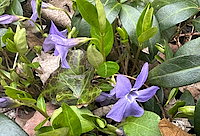
The Garden in March

All things considered we had a mild winter, and the spring flowers show it: the hellebores bloomed in carpets starting in February and the spring bulbs sprouted right on schedule, not too early so they get exposed to hard frosts, and not too late, so it's too warm for them to bloom.
March is a busy gardening month: between spring cleaning, lawn treatment and repair, planting bare root shrubs, and starting cold weather annuals there isn't a moment to waste.
Also now is the time to plant tender summer bulbs like lilies, dahlias, gladioli, torch lilies and liatris, if you haven't done so in the fall.
After the spring cleaning, the perennials grow quickly to transform the garden from an empty dirt patch to a lush paradise in a matter of weeks. While they mature, a mixture of primroses and pansies will add color and fragrance.
Pre-ordered roses ship in March, just in time for planting. Don't forget to prune the ones you already have in the garden before the forsythia blooms. For more information about which roses need pruning and how, follow this .

Hellebores

If you have a spot of clay soil in dry shade where nothing seems to thrive, you have to try hellebores.
These perennials are so versatile they earned their own fan club, just like peonies, roses and daffodils. Hellebores are prolific self-seeders and cross-pollinate to create a rainbow of hybrids.
Every spring, a circle of babies surrounds the mother plant, and all you have to do is dig them up and replant them in their permanent location. Once they adapt to their new place, they fill up quickly and grow into a full sized clump in one season. It is rare for them to produce flowers in the first year, but it happens on occasion. Their blooming season, which starts in early February and lasts until the middle of August, gives them plenty of time to mature and produce flowers in one year.
I started the hellebore patch with three plants of different varieties, Ivory Prince, Spotted Lady and Burgundy, and now I have a full garden of them in every shade of white, green, pink, rose, maroon, red and all the gradients in-between.
Hellebores are evergreen but their old leaves sprawl on the ground and become unsightly once the new clump emerges in spring. Remove the spent foliage to keep the garden tidy and the clumps vital and compact.
Other than that, they require very little care and will be happy with whatever regimen of feeding and watering you devise for the rest of the perennials.
